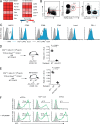Aire-expressing ILC3-like cells in the lymph node display potent APC features
- PMID: 30918005
- PMCID: PMC6504225
- DOI: 10.1084/jem.20181430
Aire-expressing ILC3-like cells in the lymph node display potent APC features
Abstract
The autoimmune regulator (Aire) serves an essential function for T cell tolerance by promoting the "promiscuous" expression of tissue antigens in thymic epithelial cells. Aire is also detected in rare cells in peripheral lymphoid organs, but the identity of these cells is poorly understood. Here, we report that Aire protein-expressing cells in lymph nodes exhibit typical group 3 innate lymphoid cell (ILC3) characteristics such as lymphoid morphology, absence of "classical" hematopoietic lineage markers, and dependence on RORγt. Aire+ cells are more frequent among lineage-negative RORγt+ cells of peripheral lymph nodes as compared with mucosa-draining lymph nodes, display a unique Aire-dependent transcriptional signature, express high surface levels of MHCII and costimulatory molecules, and efficiently present an endogenously expressed model antigen to CD4+ T cells. These findings define a novel type of ILC3-like cells with potent APC features, suggesting that these cells serve a function in the control of T cell responses.
© 2019 Yamano et al.
Figures





Comment in
-
The Aire family expands.J Exp Med. 2019 May 6;216(5):1010-1011. doi: 10.1084/jem.20190246. Epub 2019 Mar 28. J Exp Med. 2019. PMID: 30923044 Free PMC article.
References
-
- Akiyama T., Shimo Y., Yanai H., Qin J., Ohshima D., Maruyama Y., Asaumi Y., Kitazawa J., Takayanagi H., Penninger J.M., et al. . 2008. The tumor necrosis factor family receptors RANK and CD40 cooperatively establish the thymic medullary microenvironment and self-tolerance. Immunity. 29:423–437. 10.1016/j.immuni.2008.06.015 - DOI - PubMed
Publication types
MeSH terms
Substances
LinkOut - more resources
Full Text Sources
Molecular Biology Databases
Research Materials

